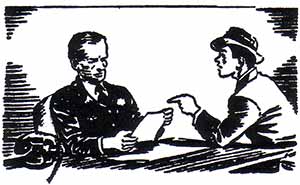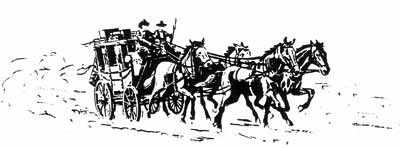|
 PRODUCE IT AGAIN, SAM: PRODUCE IT AGAIN, SAM:
The Reuse of Scripts During the Golden Age of Radio
By Stewart Wright © 2006
(From Radio Recall, April 2006)
Have you experienced the phenomenon of listening to an Old-Time Radio show that you have never heard before and as you listen, you begin to think that maybe you have heard it before? A Senior moment? An West or East Coast Broadcast of the same episode? There is another possibility: you may be listening to a radio program that used a script that was produced more than once. During the Golden Age of Radio, scripts were sometimes reused for new productions either on the same series or on other series.
Not Repeats - Actually New Productions
We are all familiar with repeats on television. Single episodes of a T.V. series may be broadcast three times in a single season; even more during their post network syndication. During Radio's Golden Age, things were generally done differently: rather than replaying previous aired transcriptions, scripts were often reused for new productions.
Yes, there were some repeat broadcasts during Radio's Golden Age. Episodes of a syndicated radio series might have been aired two or more times on a single station. Many radio series had separate broadcasts of the same episode for East and West Coast audiences. For a different scenario involving repeat broadcasts during the Golden Age of Radio, see the discussion on Gunsmoke, later in this article.
If a radio script was used again on its original series, it was normally as a new production and usually with at least a few cast or crew differences from the original production. Also, there might have been dialog and scene changes made in the script. If the new production was in a different length time slot, changes could be substantial and entail the addition or deletion of entire scenes and characters.
When the script was used on a different series, script changes could be minor or significant. Usually, at least the locale, characters' names, and minimal dialog alterations were made. However, if the newer series had a different air time length than the original series, changes might be quite extensive as mentioned in the preceding paragraph.
Why Were Scripts Reused?
In some cases, it was a matter of economics. Networks often had a limited-time option to reuse scripts on the original series or on another series. A reduced fee was usually paid to the writer for the multiple uses of a script.
A 1983 John Dunning interview with writer/director/producer Jack Johnstone, provides some insight into the reuse of radio scripts. Johnstone mentioned that he started writing radio scripts because "as the fees for writing for TV shows got bigger and fatter, these fellows, writers such as Les Crutchfield and John Dawson (AKA E. Jack Neuman), all moved over to TV. I found it increasingly difficult to get scripts of the sort that I wanted." In Johnstone's case, he added writing to his directing and producing tasks on Yours Truly Johnny Dollar.
As writers left radio for work in television, radio directors and producers were still faced with finding scripts for their shows. They could start writing scripts as Johnstone did. They could find new, less experienced writers. Or they could reuse quality, previously-written scripts on which the networks still had options. Some directors worked on several series, they sometimes reused scripts that they previously used on the same series or another series.
Many writers produced scripts for multiple radio series. Sometimes a writer would take a script that they wrote for one series and reuse the basic plot line and dialog for a script on another series. Directors probably realized that the script was not new, but were willing to reuse a proven script.
By looking at five Old-Time Radio series, we can get a good idea of the range of reuse of scripts during the Golden Age of Radio. Scripts not only were reused on the original series for which they were written, but also were used on other series on the same network and even moved to series on competing networks.
Escape and Suspense
The CBS series Escape and Suspense are prime examples of the various types of script re-use.
Twenty-eight scripts were reused with few changes for multiple productions on Escape. "A Shipment of Mute Fate" was produced on Escape four times; six other scripts were used three times on that series such as "The Country of the Blind", "Leiningen Versus The Ants", and "Three Skeleton Key."
The 1951 John Meston Romance script, "Pagosa" which was used as a model for Gunsmoke, was also produced on Escape in 1952. It was produced again on Romance in 1953.
Also, thirty scripts that were written for Escape were later produced on Suspense. In addition to changes in series openings and closings, some changes in dialog were usually made. Included are two scripts written by actor John Dehner: "Lily and the Colonel" and "The Man With The Steel Teeth." Director Antony Ellis later reused those Dehner scripts that he directed on Escape when he directed Suspense.
More than 125 Suspense scripts were reused during the roughly 20 year run of the series. Of these 26 were used at least three times. Lucille Fletcher's classic "Sorry, Wrong Number" was performed seven times with a 1960 repeat broadcast of the 1957 production.
Besides the Escape scripts, scripts from other series were reused on Suspense. Another Lucille Fletcher's script for the 1942 Suspense production of "The Hitch-Hiker" was expanded from her script that was originally used on the 1941-1942 season of The Mercury Theater of the Air. That expanded Suspense script was later reused on the 1946 series The Mercury Summer Theater of the Air. The Richard Chandlee script "Beirut By Sunrise"was initially aired on the series On Stage in 1953 and aired on Suspense in 1955. Another script from On Stage, "Heaven's To Betsy," written by Antony Ellis, was also reused by Ellis when he directed Suspense.
Antony Ellis also reused several scripts from the earlier time period when he written for and directed Escape when he directed Suspense: "A Study In Wax," "The Game," and "Classified Secret." "The Cave" script by Ellis was used on at least three series: Escape in 1950, Suspense in 1955, and Romance in 1956. Ellis was director of Suspense and Romance when "The Cave" was aired on those series.
The Ambrose Bierce short story "An Occurrence at Owl Creek Bridge" aired on both Escape and Suspense. Director William N. Robson adapted the story for Escape in 1947 and reused his adaptation on Suspense in 1956, 1957, and 1959.

Yours Truly, Johnny Dollar
At least twenty scripts written for Yours Truly, Johnny Dollar were reused for later productions on the series.
Some Gil Doud scripts from early in its run were reused before 1955 without changing the episode titles. Most initial performances of these scripts starred Edmond O'Brien; the later performances starred John Lund.
E. Jack Neuman wrote several 30-minutes Johnny Dollar scripts between 1950 and 1953 that underwent extensive revision when they were reused for 1955-56 multi-part shows. Episode titles, locales and character names were changed. It was necessary to approximately double the length of the original script for the new time format by adding characters, scenes, and dialog. Neuman used a pen name, John Dawson, for these 1955-56 efforts. A few examples of Neuman half-hour scripts which became multi-part episodes are: "The Big Red Schoolhouse Matter," "The San Antonio Matter" and "The Underwood Matter;" they became "The Clinton Matter," "The Valentine Matter" and "The Henderson Matter" respectively.
Scripts from other series found their way to the series with "the man with the action-packed expense account." One came from a somewhat surprising source.
"The Prodigal Daughter," a half-hour 1948 Jeff Regan, Investigator script by E. Jack Neuman was expanded to five, fifteen-minute segments when it was used as the 1956 Yours Truly, Johnny Dollar adventure "The Pearling Matter." For the Johnny Dollar script, extensive changes and additions were made regarding characters, scenes, and dialog. Again, Neuman used his Dawson pen name. Other Jeff Regan Neuman scripts seem to have been reused for the 1955-56 multi-part run of Johnny Dollar under the John Dawson pen name.
A Gil Doud/Bob Tallman 1948 Voyage of the Scarlet Queen script made a surprisingly easy transition to Johnny Dollar. "The Queen Anne Pistols and the Dealer on King George Road" script was reused in late 1950 on the CBS detective series as "The Queen Anne Pistols Matter." Gil Doud is credited as the writer of the Johnny Dollar script. Most of the modifications to the script dealt with changes in locale and characters. It is amazing how much of the original Scarlet Queen dialog remained in tact when used for Johnny Dollar.
At least one Johnny Dollar script was used on Suspense. The 1956 multiple-part Johnny Dollar episode, "The Curse of Kamashek Matter" by Jack Johnstone was condensed for use on Suspense during the 1962 season as "The Curse of Kamoshek." For Suspense, Johnstone used one of his pen names, Jonathan Bundy.
21st Precinct
On the CBS police drama series, 21st Precinct, forty scripts were reused by director/writer Stanley Niss. This series ran for a total of 159 episodes from 07/07/1953 to 11/01/1956. All new productions had some cast and crew changes. Several scripts were renamed when used for new productions.
The vast majority of new productions of previously used 21st Precinct scripts occurred after episode 97, which was aired on 08/13/1955. Since episode titles were not announced during the broadcast, recognizing the name of the main character, the precinct Captain, can be an important aid in distinguishing most initial airings of a script from a later production of that script:
Captain Kennelly through episode 109 and in episode 135,
Captain Cronin in episodes 109-144, and
Captain Keough in episodes 145-159.
A lengthy 21st Precinct series broadcast log can be found on the Internet at:
http://www.old-time.com/otrlogs2/21pre_sw.log.txt
Gunsmoke
Due to its popularity, Gunsmoke was unusual in that many of its episodes had repeat airings during its CBS 1952-1961 run. These non-prime time repeat airings were on Saturdays at 12:30 PM Eastern Time (9:30 AM Pacific Time) over the CBS network between mid October, 1954 and early February, 1959. They were repeat transcribed airings of the most recently aired prime-time network episode.

Some scripts that were originally written for the 1956 CBS series Fort Laramie were later reused on Gunsmoke. Norman Macdonnell directed both series. Previous research conducted at archives using the scripts in the Kathleen Hite and Gunsmoke Collections has proven that four scripts that she had originally written for Fort Laramie were used on Gunsmoke during the 1960 portion of Gunsmoke's 1959-60 season. The Fort Laramie scripts "Woman At Horse Creek", "Assembly Line", and "Hattie Pelfrey" were produced on Gunsmoke as "Solomon River", "Busted Up Guns", and "Nettie Sitton", respectively. A fourth Hite script, "Little Girl", was originally written for Fort Laramie, but was not aired on that series prior to its cancellation. This script was used for the Gunsmoke episode "Little Girl" which aired in 1960. In their transition from Fort Laramie to Gunsmoke, all four scripts received modifications in locale, characters, and dialog.
It is quite likely that some John Meston Gunsmoke scripts were adapted for use on Fort Laramie. The Gunsmoke episode "No Indians" is quite similar in plot to the Fort Laramie episode "Playing Indian." Likewise, the Fort Laramie episode "Boatwright's Story" has several similarities to the Gunsmoke episode "Gunsmuggler."
Reuse of scripts was common on Gunsmoke; 57 scripts from that series were reused for new productions during the run of the series and seven more scripts were reused for two new productions. From mid-1957 through the end of the series in mid-1961, sixty-three episodes of the series were new productions of previously used scripts. All of these new productions of reused scripts involved dialog and/or cast changes. In some cases, the episode titles were changed between productions: the 1954 script "Feud" became "Twelfth Night" in its 1955 and 1957 productions; and the script for 1952 and 1959 productions of the episode "Carmen" was reused in 1955 as "Good Girl - Bad Company." In the 1953 production of "The Cast" Paul Frees filled in as Doc Adams for Howard McNear; while in the 1958 production of the script, McNear played his usual Doc Adams character.
For more information on the reuse of scripts on Gunsmoke, see The Nostalgia Pages Gunsmoke Forum on the Internet.
http://forums.oldradio.net/ftopic1506.html
This is the Web address for the first of a series of 65 posts on the MYTH OF THE PRIME-TIME REPEATS. There is a separate post for each of the 64 scripts that were reused on Gunsmoke.
While my script reuse article is by no means exhaustive, it is obvious that reuse of scripts was common during the Golden Age of Radio. Most of these scripts had a common quality: they were excellently written.
|